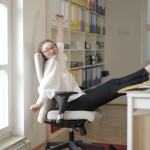Office work may not be physical, but somewhat counterintuitively, that’s what makes it so hard on our bodies, and not just the upper body. Long hours at the desk can limit blood circulation in the legs, potentially leading to a variety of health issues, from swelling and varicose veins to long-term joint stiffness.
In this article, we discuss 10 clear signs of circulatory stress in the legs. If you notice any of the issues flagged here, it’s time to take action by adjusting your office setup, changing your working habits, or potentially seeking medical advice. Look after your legs, and they’ll look after you!
1. Persistent swelling (edema)
If your ankles or calves often look puffy by the end of the workday, poor circulation may be to blame. When blood doesn’t move efficiently through the legs, fluid can build up in the tissues, leading to swelling.
While mild swelling can improve with movement or elevating your legs, swelling that doesn’t go away, or gets worse over time, should be checked by a doctor, as it can signal a more serious circulatory problem.
2. Cold feet or legs
Do your feet often feel chilly, even when the room is warm or you’re wearing socks? Poor circulation can mean less warm blood is reaching your lower extremities, leaving them colder than the rest of your body.
Occasional cold feet aren’t unusual, but if it happens often or one leg feels consistently colder than the other, it’s worth paying attention.
Related: How office workers can improve blood circulation in the legs
3. Numbness or tingling
That “pins-and-needles” sensation in your feet or calves can point to sluggish blood flow.
When circulation is restricted, nerves in the legs don’t get the oxygen and nutrients they need, which can trigger numbness or tingling. If it fades quickly after you shift position, it’s usually nothing serious, but frequent or lasting numbness is a warning sign that shouldn’t be ignored.
4. Bulging veins (varicose veins)
Those bulging, twisted veins that often show up on the calves or behind the knees are a classic sign of poor circulation. They happen when blood pools instead of flowing smoothly back toward the heart, putting extra pressure on the veins.
While varicose veins are common and sometimes only a cosmetic concern, they can also cause aching, heaviness, or throbbing pain, and in more severe cases, they raise the risk of blood clots.
5. Skin discoloration
Poor circulation can change the color of the skin on your legs and feet. You might notice pale patches, a bluish tint, or even reddish spots where blood flow is inconsistent.
These shifts in skin tone often show that oxygen-rich blood isn’t reaching the tissues as it should. Occasional mild changes after sitting cross-legged are common, but persistent discoloration is a stronger sign that your circulation needs attention.
6. Leg cramps
Sharp, tight muscle cramps in the calves or feet, especially at night or after long hours of sitting, can be linked to poor circulation. When blood flow is restricted, muscles don’t receive enough oxygen, making them more prone to spasms.
Of course, cramps can happen to anyone, but if they’re frequent or severe, it’s worth treating them as a sign your legs are under circulatory stress.
7. Slow-healing wounds
If small cuts, scrapes, or blisters on your legs take longer than expected to heal, poor circulation may be the reason. Without enough blood flow, the tissues don’t get the oxygen and nutrients needed to repair themselves.
This is a serious red flag!
Wounds that linger or worsen can lead to infections and may point to underlying conditions like peripheral artery disease. If you’re concerned wounds on your legs are healing slower than they should be, consult your doctor.
8. Weakness or heaviness in the legs
Feeling unusually tired, heavy, or weak in your legs after short periods of standing or walking after a stint at your desk can indicate that blood isn’t circulating efficiently.
Muscles rely on a steady supply of oxygen-rich blood to function properly, and when circulation is impaired, even everyday movements can feel exhausting. Persistent heaviness is a sign your legs are struggling and could benefit from more movement or medical evaluation.
9. Hair loss or slower hair growth on the legs
Changes in hair growth on your legs can be a subtle but telling sign of poor circulation. When blood flow is restricted, hair follicles may not receive enough nutrients, causing hair to thin or grow more slowly.
While this can happen naturally with age, sudden or noticeable hair loss on the legs is a warning that circulation may be compromised and worth monitoring.
10. Shiny, tight-feeling, or thin leg skin
Poor circulation can also affect the texture and appearance of your skin. Legs may start to look unusually shiny or feel tight, and the skin can appear thinner than normal, sometimes almost translucent, making veins more visible. These areas may bruise more easily or feel sensitive to the touch.
This happens because reduced blood flow deprives skin cells of essential nutrients and oxygen. While subtle changes are easy to miss, noticeable or worsening skin alterations are a sign that circulation needs attention and, in some cases, medical evaluation.
Make office work sustainable with Cardinus
If you or members of your office-based team are experiencing symptoms of poor blood circulation in the legs, it’s likely a sign of serious ergonomics issues in workstation setup and equipment.
At Cardinus, we specialize in ergonomics risk management, providing a range of solutions to encourage healthier, happier working. Whether you need a complete end-to-end office ergonomics management program like our Healthy Working software, or a one-off ergonomics assessment, we can help.
Contact us today to discuss your needs, and we’ll advise on a tailored solution.





